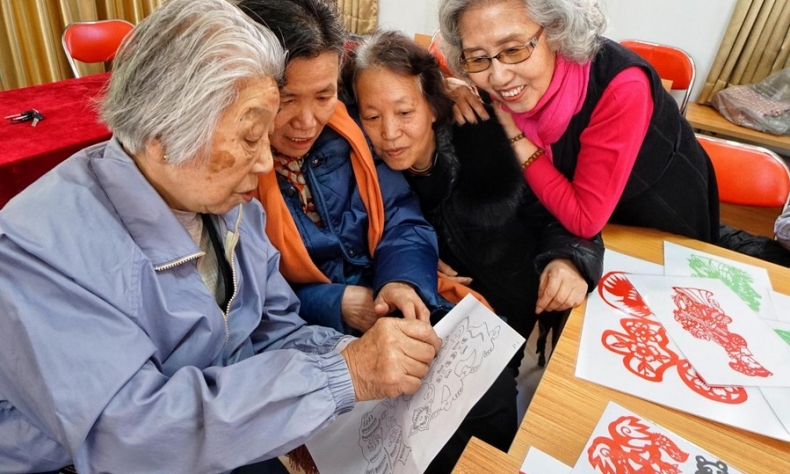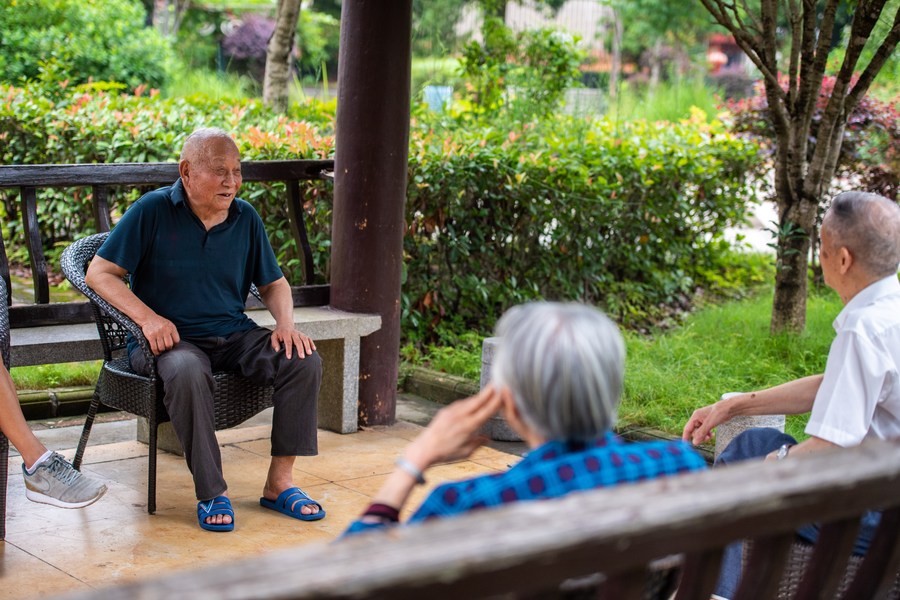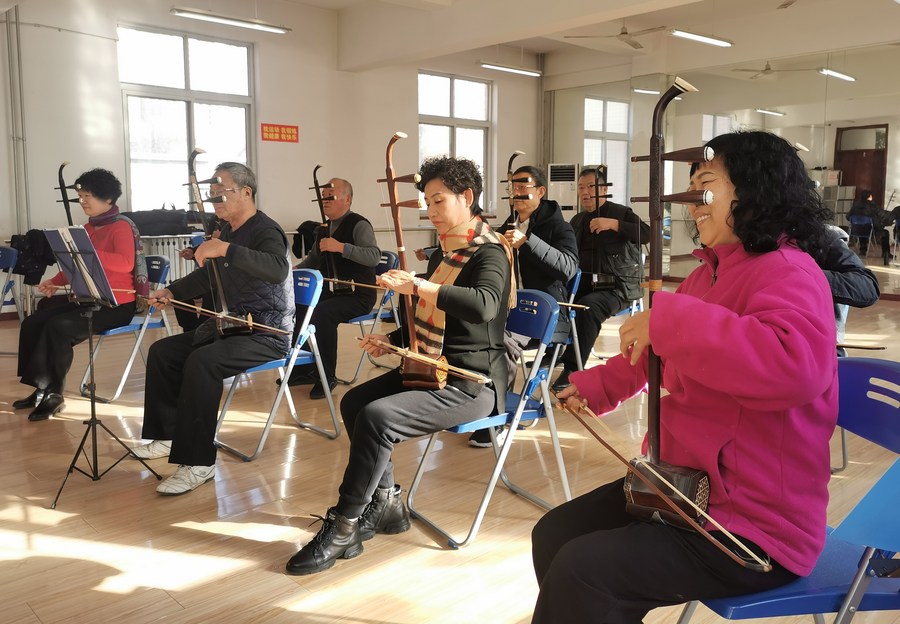Diversified Elderly Care Services to Promote the Silver Economy

China is striving to build an elderly-friendly society, with comfortable living facilities, convenient transportation, and accessible leisure services.
The Chinese path to modernization entails the modernization of a huge population. Part of this, as was declared at the 20th National Congress of the Communist Party of China (CPC), means China will pursue a proactive national strategy in response to population aging, and develop elderly care programs and services.
To actively respond to population aging, there is more to care than just the physical health of the elderly. Their needs are multi-level and diverse. To some extent, it’s fair to say that a society’s happiness is largely dependent on whether or not the elderly are happy. The silver economy, which meets the needs of the elderly for a better life, therefore has enormous development potentials.
Happiness in old age
Following the music, I walked into the Hongshiliu (red pomegranate) residential compound in Qapqal Town, Qapqal Xibe Autonomous County in Xinjiang Uygur Autonomous Region, where 68-year-old Lahamutuer Taxilahong is playing the Dombra, a traditional plucked string instrument in Xinjiang. The audience clapped with the rhythm while singing along.
A lively and joyful community gathering was taking place here. Retired residents gathered, singing and dancing, drawing cheers from the crowd. “Whenever the community organizes social events, I will come to play a tune,” said Lahamutuer.
According to Zhu Pengbo, Party secretary of Hongshiliu, the residential compound was built in April 2017, with a total population of 7,327 from 14 ethnic groups. To facilitate exchanges among retirees, a library, an activity room, a cultural and sports center, and an outdoor cultural activity square with a total area of 1,200 square meters have been built, regularly hosting diverse cultural activities.
In Chinese poetry, there are two famous lines: Never say too late because of old age; the glow of sunset still brightens the sky.” In the face of the growing cultural needs of the elderly, three central administrations issued in 2021 a guideline on promoting high quality development of public cultural services, saying that the state will provide more suitable cultural products and services for elder people to enjoy a better cultural life. This is not only an exploration in response to an aging population, but also a significant measure to improve the supply of elderly care services.
In the old-age community Chengxin in Beijing’s Chaoyang District, Dajia Insurance has created public cultural spaces such as classrooms for painting and calligraphy, music, dancing, and handicrafts to provide high-quality elderly care services. “I have lived here since the Dragon Boat Festival in 2022 and started learning watercolor painting. Now, I have mastered more painting skills, and I feel so fulfilled,” said Ms. Lu, proudly displaying her painting called Little Deer.

Chengxin charges around RMB 10,000 per person each month, attracting high-income retirees with its good services. Yang Shu, general manager of the operation and management section of Dajia Health and Elderly Care Industry Investment Management Co., Ltd., stated that high dietary, recreational, and housing standards for daily living could ensure the elderly a healthy body and mind. The company’s recreational services cover six major categories such as mental health care and educational development, with up to five activities organized each day and 90 to 150 activities per month. More than 30 senior-friendly and intelligent facilities provide additional reassurance for the elderly residents.
Learning in old age
Immediately after the New Year’s day, various senior colleges wrapped up their 2023 academic year, and enrollment for the spring semester of 2024 was underway.
In the college for the elderly in Dongcheng District of Beijing, there is a list of innovative courses for the upcoming spring semester, including mobile photography and video production, as well as classes about The Yellow Emperor’s Canon of Internal Medicine (the earliest and most important written work of traditional Chinese medicine). “I worked in the transportation sector before retiring. After retirement, I started learning landscape painting. Later, I enrolled in Dongcheng’s college for the elderly and have been studying painting here for over three years,” said a 63-year-old student. She mentioned that the tuition at the college was affordable, and she planned to continue registering next year to explore new courses.
According to data from the National Bureau of Statistics (NBS), in 2022, China’s population aged 60 and above reached 280.04 million, accounting for 19.8 percent of the national total. Among them, the population aged 65 and above was 209.78 million, representing 14.9 percent of the national total. As the age of the Chinese society continues to rise, enrolling in universities for the elderly has become a popular choice, and the market demand for lifelong learning continues to expand.
With the generation born between 1962 and 1975 entering retirement, they differ significantly from the previous generation in cultural literacy, income, assets, and family structure. Consumer demands are shifting to be high-level, high-quality, and diversified.
As early as 2020, the State Council issued a guideline on promoting the healthy development of elderly care and childcare services, supporting various institutions in organizing senior universities. It also advocated for the establishment of open universities for senior citizens and online senior universities to build a nationwide platform for sharing elderly education resources and public services.
Research shows that universities for senior citizens are popular and it is often difficult to secure a spot in popular classes. Currently, the tuition fees are generally between RMB 100-200 per person per course, with popular courses such as traditional Chinese painting and calligraphy costing around RMB 300. As of April 2023, there are over 76,000 senior universities at various levels nationwide, widely distributed across the country, with an enrollment of over 20 million.

To bridge the digital gap for the elderly, the 14th five-year plan for the public cultural service system emphasizes adapting to the aging population, providing digital skills and cultural training, and effectively addressing the difficulties elder people face in using smart technologies. Therefore, enhancing online education and other digital services for the elderly will become a significant aspect of the silver economy.
Migratory-style retirement
“The weather in Hainan during winter is pleasant, with clear skies and fresh air, which is good for the health of the elderly,” said Wang Jinyu. Since 2016, Wang and his family have chosen to spend winters in Hainan. They even purchased a house there with plans to celebrate the Chinese New Year in Hainan every year.
As the only tropical province in the country, with the influx of a large number of “migratory elderly” every winter, Hainan welcomes new opportunities for economic and social development. “The cost of living in Hainan is much lower than that in Beijing. We eat well, live comfortably, and enjoy our time here,” said Wang, citing climate and living costs as their primary reasons for spending their retirement life in Haikou.
“We also bought a house in Weihai (a coastal city in Shandong Province) and spend summers there by the seaside,” said Wang. He added that there are many families adopting a “migratory-style” lifestyle like his, moving south in winter and north in summer. Seeing the new lifestyle, many regions are accelerating the development of the health resort industry, driving local economic growth.
Regarding vacationing in different places after retirement, Guo Hanqiao, deputy director of the Beijing Civil Affairs Bureau, indicated that Beijing will leverage the collaborative mechanism for elderly care services in the Beijing-Tianjin-Hebei region and the cooperative mechanism for such services between Beijing and Hainan. They will develop high-quality and affordable health resorts and vacationing facilities for retirees, promoting migratory-style retirement for Beijing’s elderly. The goal is to encourage and support Beijing’s elderly to spend winters in Hainan and summers in northern regions like Hebei and Inner Mongolia, meeting the diverse needs of over 90 percent of senior citizens for multi-level and diversified retirement services.
However, Wang also expressed some concerns, “Currently, the medical resources in Hainan and Weihai are not as abundant as in Beijing, and there are differences in the medical insurance policies in different regions.” Some regions are taking action in response to this general concern. At the 2023 Boao Forum for Entrepreneurs, the Civil Affairs Departments of Heilongjiang Province and Hainan Province signed a framework agreement to cooperate on retirees’ vacationing in other regions. The two provinces will establish mechanisms for sharing elderly care resources and mutual recognition of elderly care service standards.
In the future, against the backdrop of an aging population, senior tourism will become a crucial growth engine of the tourism industry. As indicated in a development report on China’s elderly tourism and health resort industry released by the China Tourism Academy, the new generation of senior citizens are showing better health conditions, have more leisure time, modern consumptions needs, a greater desire to travel, and stronger spending power.
 Facebook
Facebook
 Twitter
Twitter
 Linkedin
Linkedin
 Google +
Google +










